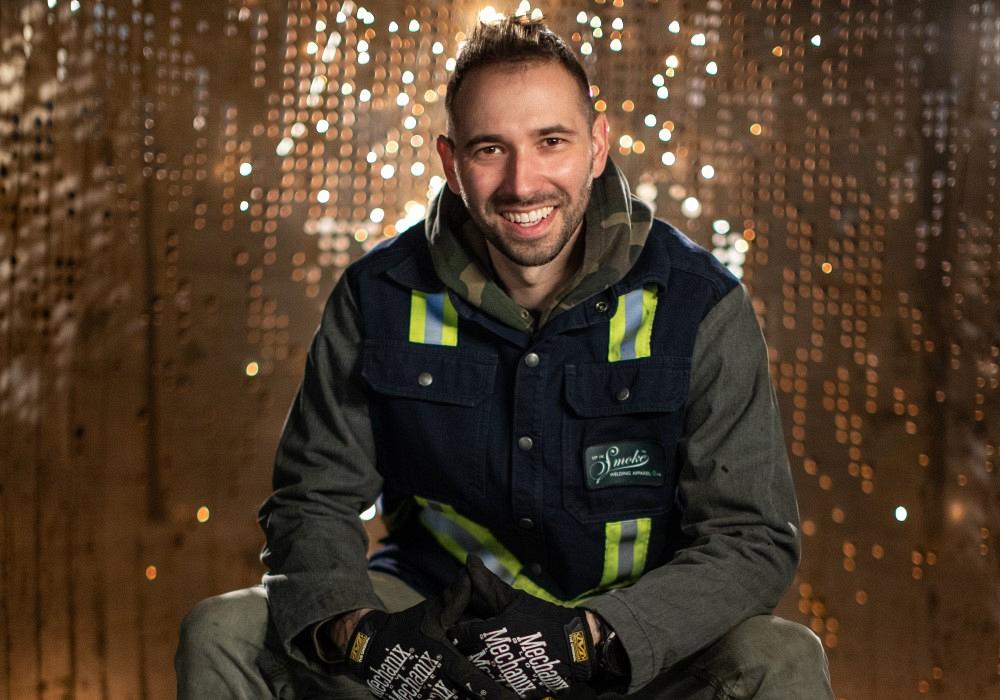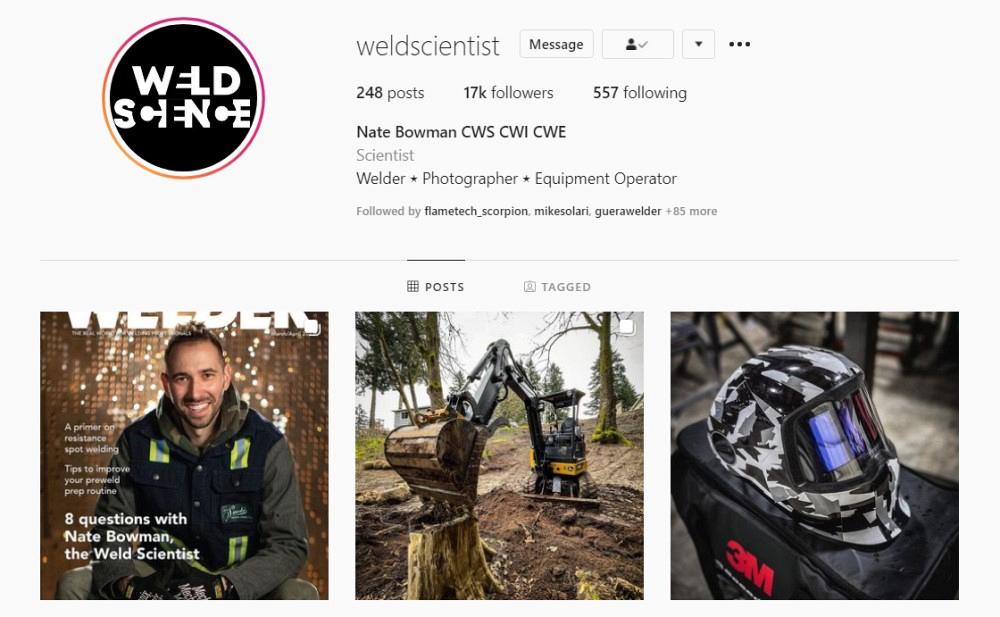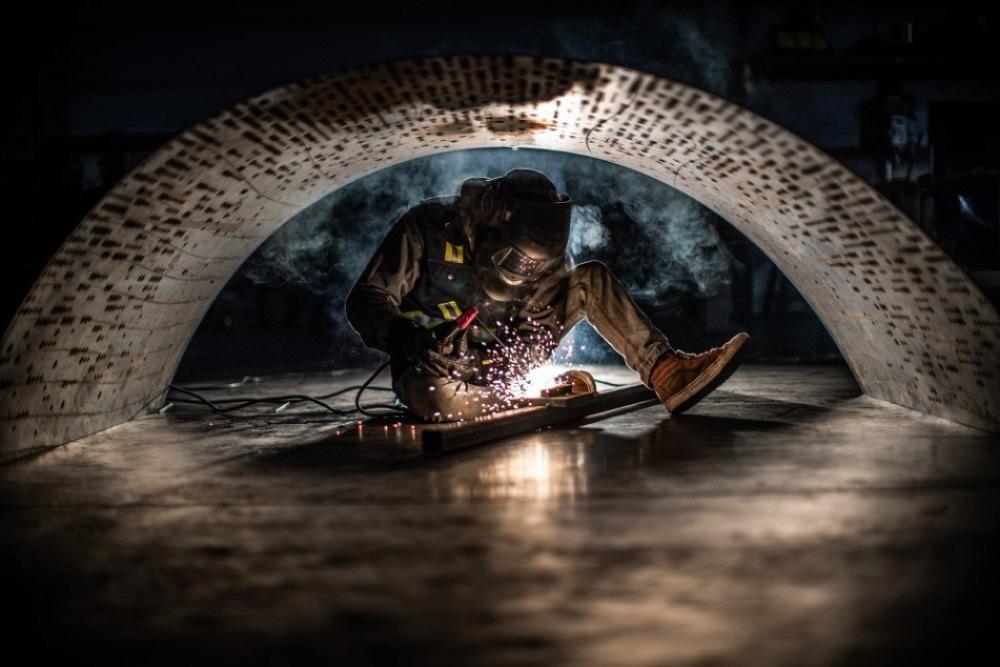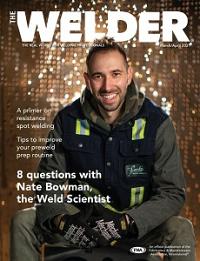- FMA
- The Fabricator
- FABTECH
- Canadian Metalworking
Categories
- Additive Manufacturing
- Aluminum Welding
- Arc Welding
- Assembly and Joining
- Automation and Robotics
- Bending and Forming
- Consumables
- Cutting and Weld Prep
- Electric Vehicles
- En Español
- Finishing
- Hydroforming
- Laser Cutting
- Laser Welding
- Machining
- Manufacturing Software
- Materials Handling
- Metals/Materials
- Oxyfuel Cutting
- Plasma Cutting
- Power Tools
- Punching and Other Holemaking
- Roll Forming
- Safety
- Sawing
- Shearing
- Shop Management
- Testing and Measuring
- Tube and Pipe Fabrication
- Tube and Pipe Production
- Waterjet Cutting
Industry Directory
Webcasts
Podcasts
FAB 40
Advertise
Subscribe
Account Login
Search
The Weld Scientist unmasked
8 questions with Nate Bowman: talking careers, education, welding, and Instagram
- By Amanda Carlson
- March 24, 2021
- Article
- Arc Welding

Nate Bowman's own weld journey has given him plenty of insight to share to make the pathway for others a little less turbulent than the one he experienced. Photos: Jesse Larson
Nate Bowman is not a scientist.
The 33-year-old resident of Vancouver, Wash., doesn’t even play one on television, but he’s known on Instagram as Weld Scientist.
Make no mistake, Bowman isn’t some guy who’s pretending when it comes to welding knowledge. He’s earned his CWI, CWE, and CWS credentials and has a diverse professional background, giving further weight to his words.
But he’s still relatively young. How much could he really know, right?
He’s heard that argument. A lot. He had some tough experiences as a young welder that could have jaded him toward the welding industry and manufacturing work as a whole. He had legitimate questions about requirements or standard practices that he didn’t understand; he had ideas on how to change things; he knew what his work was worth; essentially, he had a lot of passion for his craft that was interpreted as youthful arrogance. As a result, Bowman felt like the odd man out a lot. But he never felt like his thoughts or opinions weren’t valid.
This led to a rather nomadic professional journey that included stints as a production welder, custom fabricator, weld instructor, and weld consultant. Good or bad, he learned from each situation and became a well-rounded welder/fabricator with much insight to share. And now he’s found a career that gives him the freedom to be himself.
There isn’t much about the welding industry that he can’t equate to a personal story from his past. So, it should surprise no one that he has a lot to say, not just about his own weld journey, but what can and should happen to make the pathway for others a little less turbulent than the one he experienced.
The WELDER sat down with Bowman and talked about everything from how he ascended industry ranks to his opinion on commonly discussed topics in welding.
How did you get into welding?
In a way I’ve always known what I wanted to do. My dad had a construction company when I was a kid. So I was around construction and the skilled trades work quite a bit. I remember the first time I saw welding. We were at this shop where my dad brought his skid steer for repairs and there was a guy there welding. I can remember it clearly – I was like 5 years old or something. I thought it was awesome.
The television show “Monster Garage” came out when I was 12 or 13 years old and I loved it. From there I started watching “Junkyard Wars,” “Orange County Choppers,” and “MythBusters.” I was super into science and problem-solving, so shows like those brought that interest to life and made it all seem very cool.
I talked to my guidance counselor in high school and was able to get into a welding program. I lived in a rural community, so I was bussed to the inner city to take this class because there was no welding program where I lived. My welding instructor was a supercool old ironworker. I don’t remember learning a lot about how to set the machine, but I know he did his best and he fanned the flames of enthusiasm for welding for me.
What steps did you take to get a foot in the door in industry?
I went directly into the Air Force after high school. I had this idea that I was going to weld on aircraft, which turns out is not really a thing. But I did go to school for sheet metal fabrication, where I learned a lot about corrosion control, painting, fabrication, and a tiny bit of metallurgy, but no welding.
After I got out I moved to upstate New York and I got my first welding job at a trucking company and I loved the work. I’ve had a lot of crappy jobs over the years and I’ve learned that you’ve got to try and have fun, even if it sucks. Well, the guys that I worked with didn’t like that, so they ended up letting me go because nobody liked me.
I was working full-time at a hotel when I enrolled in a six-month welding program. I was superstoked to be a welder and I really cared about doing well. The teacher there insisted that we all get structural steel certifications in 7018 stick welding. He told us that was our golden ticket.
I could watch my instructor do something and mimic it, and then he stopped showing me how to do stuff. He called me Air Force One because I was dialed in all the time. It was weird having an instructor mock me, but I just kept doing my thing.
The second month into the program I decided to take the certification test. Our school was a testing facility so I paid out of pocket to take the test along with other guys in the industry, and I passed. That gave me the validation that I was doing the right thing.
I worked at a place that made subassemblies for G.A. Braun Inc. I went there while I was still in welding school to see if they were hiring. The secretary said they weren’t, but that I could leave my resume behind. So I ran out to my truck and grabbed it, and when I got to the front door, the owner was there waiting for me. He liked my hustle and hired me.
I realized right away that I was in over my head. I had been studying stick welding in school, but these guys were doing mostly MIG. I had so little experience with MIG, especially short-circuit on stainless steel. I realized I had been missing out on quite a bit by focusing on stick welding. At that point I was ready to leave school. I didn’t care if I didn’t get my certificate of completion – I had already earned my certification.
You’ve had a difficult time finding the right fit professionally. What have been the biggest takeaways from those experiences?
I’m 33 years old now. If people want to say things about me or make fun of me, that’s fine. I’m very happy with where I’m at right now, but looking back on the stuff I dealt with and how much of a battle it was for me, that’s what fueled me. It’s why I do the things I do now. I’ve always felt like people looked down on me for being so passionate about this trade.
I just try to show people that it’s OK to be different than other people. It’s OK to be a welder and be smart. A lot of welders buy into the perception that welders are dirty and dumb so they don’t realize how valuable their skills are or how much they are worth and they end up staying at a crappy job forever.
You have to be your own advocate and be brave enough to put yourself in an environment that’s rewarding for you and where you feel valued.
Tell us about what you’re doing currently.
I’m the director of welding optimization and education at Central Welding Supply in Vancouver, Wash. It sounds really fancy, but basically I help customers compete. We have 35,000 customers – not all of them involve welding – but for the ones who do, if they are having problems in the weld processes, if they want to try out new equipment, want to develop welding procedures, or if they have welding failures, then they’ll come to us for help.
Because of my past problems with welding instructors, I work with a ton of schools and connect teachers with continuing education opportunities. That’s something we offer at Central Welding Supply free of charge. I go out to schools and conduct continuing education for high school and college welding instructors. We meet as a group and do question-and-answer sessions where everyone can ask questions or share things that work or don’t work for them.
Do you receive a lot of questions from people because of your Instagram handle?
The most common question I get is about weld settings. A lot of people reach out, asking me where to set their machines. I probably get on average two messages a day from random people. I always encourage people to reach out and ask questions. And if I don't know, I just say that I don't know.
Sometimes I have to reach out to somebody else to get an answer, or I have to go to the whiteboard and do a bunch of math and then get back to them. Most of the questions that I get are about machine settings, the best wire and gas combinations, and achieving spray transfer. And I have like a cheat sheet that I made with all the optimal settings for different wires that I send to anyone who wants it.
Do you believe there is a skills gap in the welding industry? Or do you believe it is a pay gap?
I think both exist. Actually, I think there are three components to this.
First, I don’t think that there’s a shortage of people willing to do the work, but I do believe that the pathway to the work is broken. I know of an instructor at a high school local to me who studied engineering in college and was asked to teach welding. He had like a month of welding experience in college, but he’s an engineer. He doesn’t know anything about how to get a welding job, so how can he prepare his students for something that he’s never done?
Second, when we talk about a skills gap, I think some high schools and community colleges do a poor job of preparing students for employment. Many instructors rely on passing down knowledge in the same way they were taught. But we have to ask ourselves, why? Is that really the best way to do it? There are so many jobs that require skills in MIG, flux-core, and TIG.
Why do weld classes spend the first month practicing how to oxyacetylene weld? When’s the last time you saw that in industry? And the argument that oxyacetylene welding is just like TIG just doesn’t add up.
It might be similar in one way, but saying that gives people a completely false understanding of heat input and how it works, and it convinces people that welding with fire is the same as welding with electricity, and it isn’t. This has happened to me. When I took that welding class back in New York, my instructor insisted that we all get a structural steel SMAW certification. Well, I’ve used it one time since then.
Third, I think there’s an unwillingness for people to jump ship when their employer sucks. I worked with a guy once who spent 37 years with the company and was one of the most talented welders I’ve ever seen in my life. But he lived in a shack and drove a crappy car and was not earning what I felt he deserved. So, I thought to myself, "Is this where I’m headed?" At that point I had already battled the owner to give me 50 cents more an hour. If that was the case for me, what was this guy making after 37 years?
I think high school and community colleges would benefit from having a system in place to connect students with local job opportunities. That’s something I’m working on at my job. Eventually I’d like to have an internal jobs board where our customers can post job openings, and from there local weld instructors can take a look at that and guide students who have the skill set needed toward these employers.
Are young welders too often unfairly stereotyped as being lazy and unmotivated?
I don’t think younger people are necessarily less motivated, I just think they feel their ideas get shot down immediately. I remember getting shot down all the time, and now I see that happening to others in industry. I think that begins to wear on you after a while and you begin to lose that energy that you had when you first started.
I’ve been doing this for 18 years and I still don’t know everything. I don’t believe I ever will. I have nine letters at the end of my name, and I have no problem admitting that I don’t know everything. But there are a lot of people out there who didn’t put in the work that I have that go around telling everyone that they know everything.

Nate Bowman isn’t a scientist, but his weld journey, which has included stints as a production welder, custom fabricator, weld instructor, and weld consultant, has given him plenty of insight to share.
From your perspective, how has social media influenced the welding industry?
Seeing other welders have success and being stoked about their success is what makes the welding community a little bit different than it used to be, and that’s because of Instagram.
I remember when “Welding Instagram” first started and there were a handful of people doing freehand weaves. Now everyone does it. It’s no longer just the elite guys who are able to do it. Everyone has the Monster cup and the customized TIG torch, so they’re able to lay down these amazing welds. That’s entirely because of Instagram and the dialogue that takes place between welders in the posts.
There are so many really good welders who use Instagram to help spread knowledge, and that elevates everyone’s abilities. When I was out working in shops, if I tried to ask the older guys a question, they oftentimes wouldn’t help me. But that’s the old mentality. The new mentality is sharing knowledge and helping each other out.
I and guys like Sean Flottman (Dabs Wellington) and Rush Kane (Kane Kid) are all working on our own stuff, but we’ll help you and tell you anything you want to know. That’s how we all keep growing. And if you end up being a better welder than any of us, good! That’s awesome.
About the Author

Amanda Carlson
2135 Point Blvd
Elgin, IL 60123
815-227-8260
Amanda Carlson was named as the editor for The WELDER in January 2017. She is responsible for coordinating and writing or editing all of the magazine’s editorial content. Before joining The WELDER, Amanda was a news editor for two years, coordinating and editing all product and industry news items for several publications and thefabricator.com.
About the Publication
subscribe now

The Welder, formerly known as Practical Welding Today, is a showcase of the real people who make the products we use and work with every day. This magazine has served the welding community in North America well for more than 20 years.
start your free subscription- Stay connected from anywhere

Easily access valuable industry resources now with full access to the digital edition of The Fabricator.

Easily access valuable industry resources now with full access to the digital edition of The Welder.

Easily access valuable industry resources now with full access to the digital edition of The Tube and Pipe Journal.
- Podcasting
- Podcast:
- The Fabricator Podcast
- Published:
- 04/30/2024
- Running Time:
- 53:00
Seth Feldman of Iowa-based Wertzbaugher Services joins The Fabricator Podcast to offer his take as a Gen Zer...
- Industry Events
Pipe and Tube Conference
- May 21 - 22, 2024
- Omaha, NE
World-Class Roll Forming Workshop
- June 5 - 6, 2024
- Louisville, KY
Advanced Laser Application Workshop
- June 25 - 27, 2024
- Novi, MI
Precision Press Brake Certificate Course
- July 31 - August 1, 2024
- Elgin,


































